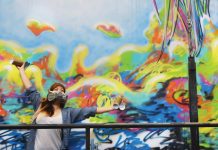
The Pompano Beach Cultural Affairs Department has announced a new Short-Term Artist-in-Residence Program to help emerging artists grow in their craft. The first participant is M. Jamesly Saint Louis, better known as Jamezly. A graduate of Dillard High School’s Visual & Performing Arts magnet program, Jamezly has been granted access to a studio at Bailey Contemporary Arts to build his portfolio for the Rhode Island School of Design, where he was recently admitted. He’s also working on a coloring book project depicting local luminaries such as Esther Rolle. In his art, Jamezly seeks to “center Blackness in all lights.” Here, he discusses this goal and advice for young artists.
FLI: When did you first realize that you enjoyed the visual arts?
Jamezly: I moved to Florida from Haiti when I was 2. When I was younger, we did not have cable, so I began drawing cartoons to occupy my time. I was enrolled in the magnet program at Parkway Middle School for the Arts and Dillard High School afterwards, and during my time in both of these places my passion for art was nurtured. My teachers were very supportive of my aspirations and truly challenged me to keep growing and experimenting. I was also able to participate in extracurricular art programs such as ArtStART.
During my time at Dillard I was inspired to explore painting after watching the Kehinde Wiley documentary An Economy of Grace. It inspired me to make the decision to lock myself in my room and paint every day during the summer of 2018. I’ve only been painting for two years, so I am still learning a lot while working at Bailey. I’m glad that I made that decision though because I’m sure that’s one of the reasons why I was awarded admission into the Rhode Island School of Design.
What have you most enjoyed about your time creating at Bailey Contemporary Arts thus far?
This has been an extraordinary opportunity. Bailey Contemporary Arts offers a myriad of ways to nurture and promote artists—studio spaces, exhibitions, events, and promotion. But for me, sharing a space with other artists who have long-term successful careers is very inspiring and instrumental in enhancing my entrepreneurial skills.
My time at Bailey has also been impactful because the venue is highly focused on the community. The entire Pompano Beach Arts precept is based upon supporting local artists, creating educational programs, and developing ways to give back to others. All of these elements are very important to me. Part of my time here has been dedicated to creating artwork featuring Pompano Beach icons which will become part of a coloring project to help educate and inspire local children. This a project I am very proud of!
Who are some artists that you look up to and what do you admire about their work?
I could go on forever with artists who inspire me. But if I have to narrow it down, here is my list: Kehinde Wiley, Toyin Ojih Odutola, Meleko Mokgosi, Titus Kaphar, Riley Holloway, Kerry James Marshall, Barkley Hendricks, and Charles White. All of them are Black artists, and while their work ranges in medium, they are creating work about Black people and that really inspires me.
Why are the visual arts uniquely poised to share Black experiences with a diverse audience?
I believe visual arts can be transformative because of the feelings evoked and the way images remain in your brain and soul. The visual arts have the power to convey a message that allows diverse people to share a connective experience. Through much of my portraiture work, which often features my friends, I feel I am able to showcase real Black people on canvas, celebrating our culture and openly displaying an array of emotions, from Black joy to Black trauma. I also feel visual arts can provide tremendous positive reinforcement, especially to Black youth as representation is so important—it is how I express communal care.
How has your work evolved in response to recent racial justice protests?
I have tackled police brutality with a series of digital illustrations that address injustice and racial profiling. This series was done a while ago, as this has been a critical issue for a very long time in the Black community. In this series, the faceless police officers wear badges emblazoned with “shoot,” “imprison,” and “silence,” while the other characters have targets for faces. Unfortunately, I feel that these pieces remain relevant, but my hope is that I stir the emotions and actions that lead to real, substantial change.
What would you say to young artists who are looking to make an impact?
I believe that answer is twofold. In the creative realm, always continue pushing yourself to grow. Try new styles, experiment, and be bold in expressing your thoughts and feelings. And equally important, every young artist must also be an entrepreneur. Marketing yourself with your business card, website, and social media and connecting with other artists and curators are all steps to getting your work seen, and then hopefully making an impact.










Facebook Comments